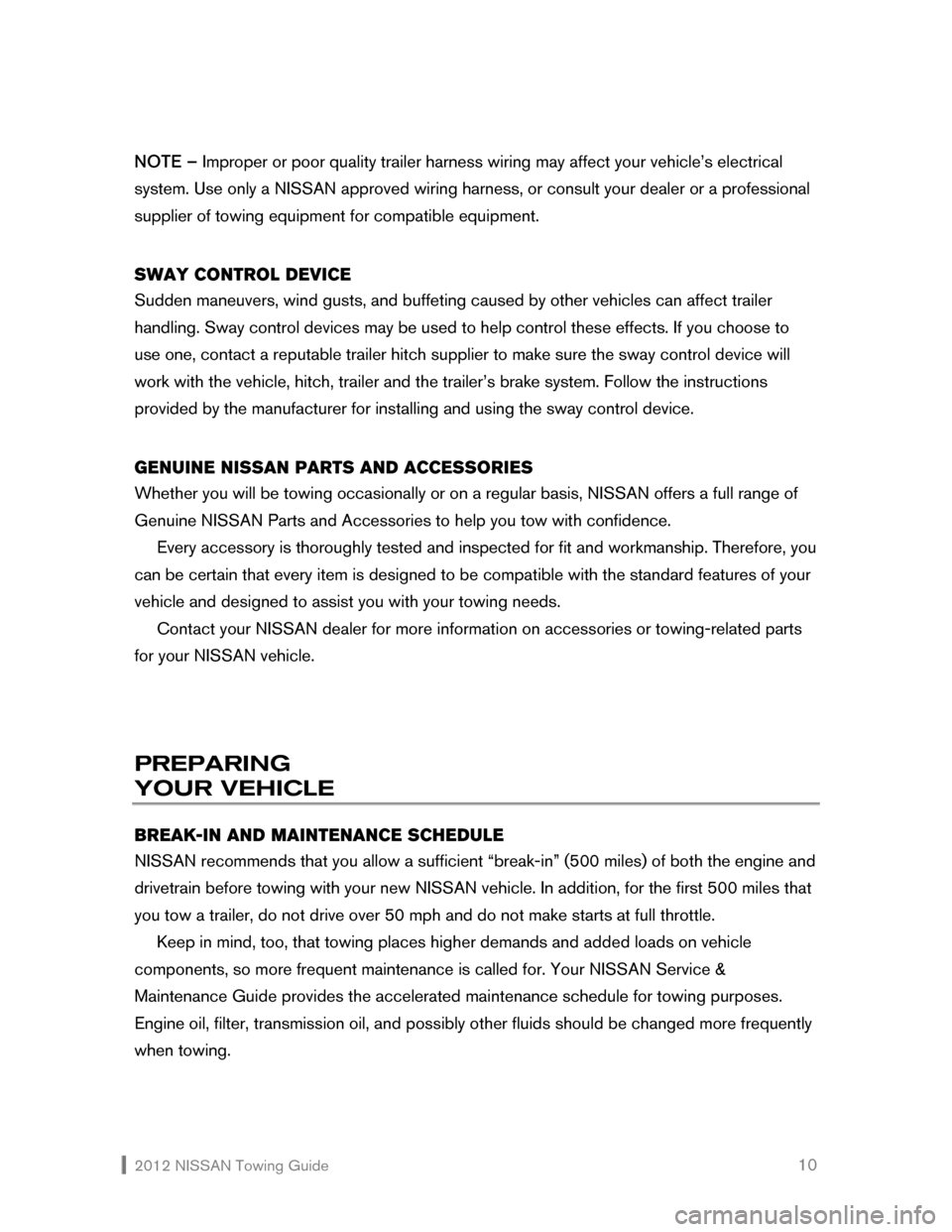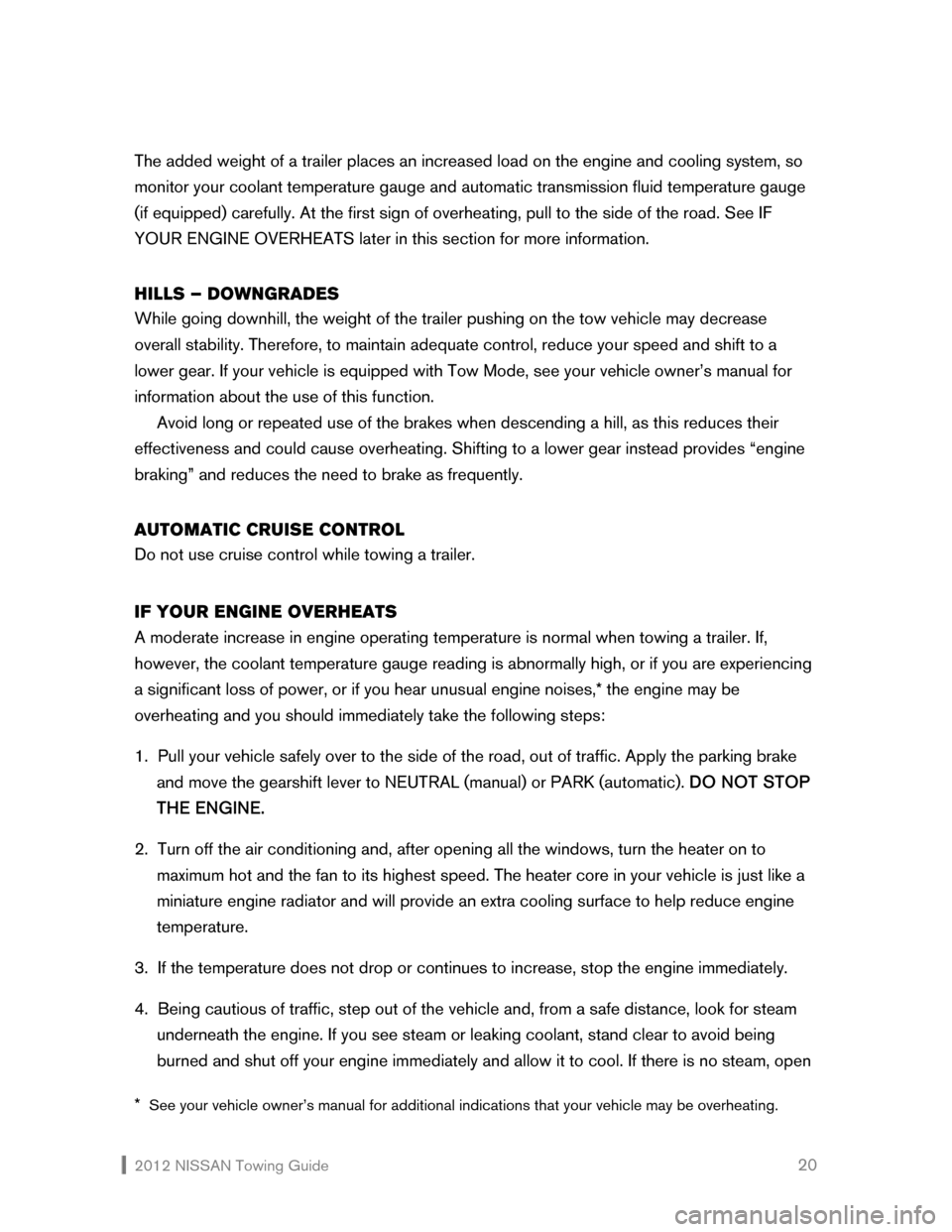transmission fluid NISSAN CUBE 2012 3.G Towing Guide
[x] Cancel search | Manufacturer: NISSAN, Model Year: 2012, Model line: CUBE, Model: NISSAN CUBE 2012 3.GPages: 27, PDF Size: 2.93 MB
Page 11 of 27

2012 NISSAN Towing Guide 10 NOTE – Improper or poor quality trailer harness wiring may affect your vehicle’s electrical
system. Use only a NISSAN approved wiring harness, or consult your dealer or a professional
supplier of towing equipment for compatible equipment.
SWAY CONTROL DEVICE
Sudden maneuvers, wind gusts, and buffeting caused by other vehicles can affect trailer
handling. Sway control devices may be used to help control these effects. If you choose to
use one, contact a reputable trailer hitch supplier to make sure the sway control device will
work with the vehicle, hitch, trailer and the trailer’s brake system. Follow the instructions
provided by the manufacturer for installing and using the sway control device.
GENUINE NISSAN PARTS AND ACCESSORIES
Whether you will be towing occasionally or on a regular basis, NISSAN offers a full range of
Genuine NISSAN Parts and Accessories to help you tow with confidence.
Every accessory is thoroughly tested and inspected for fit and workmanship. Therefore, you
can be certain that every item is designed to be compatible with the standard features of your
vehicle and designed to assist you with your towing needs.
Contact your NISSAN dealer for more information on accessories or towing-related parts
for your NISSAN vehicle.
PREPARING
YOUR VEHICLE
BREAK-IN AND MAINTENANCE SCHEDULE
NISSAN recommends that you allow a sufficient “break-in” (500 miles) of both the engine and
drivetrain before towing with your new NISSAN vehicle. In addition, for the first 500 miles that
you tow a trailer, do not drive over 50 mph and do not make starts at full throttle.
Keep in mind, too, that towing places higher demands and added loads on vehicle
components, so more frequent maintenance is called for. Your NISSAN Service &
Maintenance Guide provides the accelerated maintenance schedule for towing purposes.
Engine oil, filter, transmission oil, and possibly other fluids should be changed more frequently
when towing.
Page 21 of 27

2012 NISSAN Towing Guide 20 The added weight of a trailer places an increased load on the engine and cooling system, so
monitor your coolant temperature gauge and automatic transmission fluid temperature gauge
(if equipped) carefully. At the first sign of overheating, pull to the side of the road. See IF
YOUR ENGINE OVERHEATS later in this section for more information.
HILLS – DOWNGRADES
While going downhill, the weight of the trailer pushing on the tow vehicle may decrease
overall stability. Therefore, to maintain adequate control, reduce your speed and shift to a
lower gear. If your vehicle is equipped with Tow Mode, see your vehicle owner’s manual for
information about the use of this function.
Avoid long or repeated use of the brakes when descending a hill, as this reduces their
effectiveness and could cause overheating. Shifting to a lower gear instead provides “engine
braking” and reduces the need to brake as frequently.
AUTOMATIC CRUISE CONTROL
Do not use cruise control while towing a trailer.
IF YOUR ENGINE OVERHEATS
A moderate increase in engine operating temperature is normal when towing a trailer. If,
however, the coolant temperature gauge reading is abnormally high, or if you are experiencing
a significant loss of power, or if you hear unusual engine noises,* the engine may be
overheating and you should immediately take the following steps:
1. Pull your vehicle safely over to the side of the road, out of traffic. Apply the parking brake
and move the gearshift lever to NEUTRAL (manual) or PARK (automatic). DO NOT STOP
THE ENGINE.
2. Turn off the air conditioning and, after opening all the windows, turn the heater on to
maximum hot and the fan to its highest speed. The heater core in your vehicle is just like a
miniature engine radiator and will provide an extra cooling surface to help reduce engine
temperature.
3. If the temperature does not drop or continues to increase, stop the engine immediately.
4. Being cautious of traffic, step out of the vehicle and, from a safe distance, look for steam
underneath the engine. If you see steam or leaking coolant, stand clear to avoid being
burned and shut off your engine immediately and allow it to cool. If there is no steam, open
* See your vehicle owner’s manual for additional indications that your vehicle may be overheating.